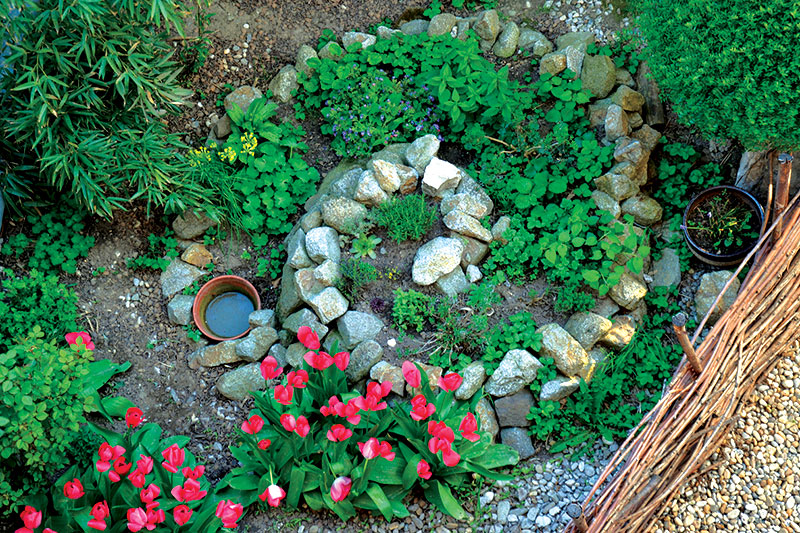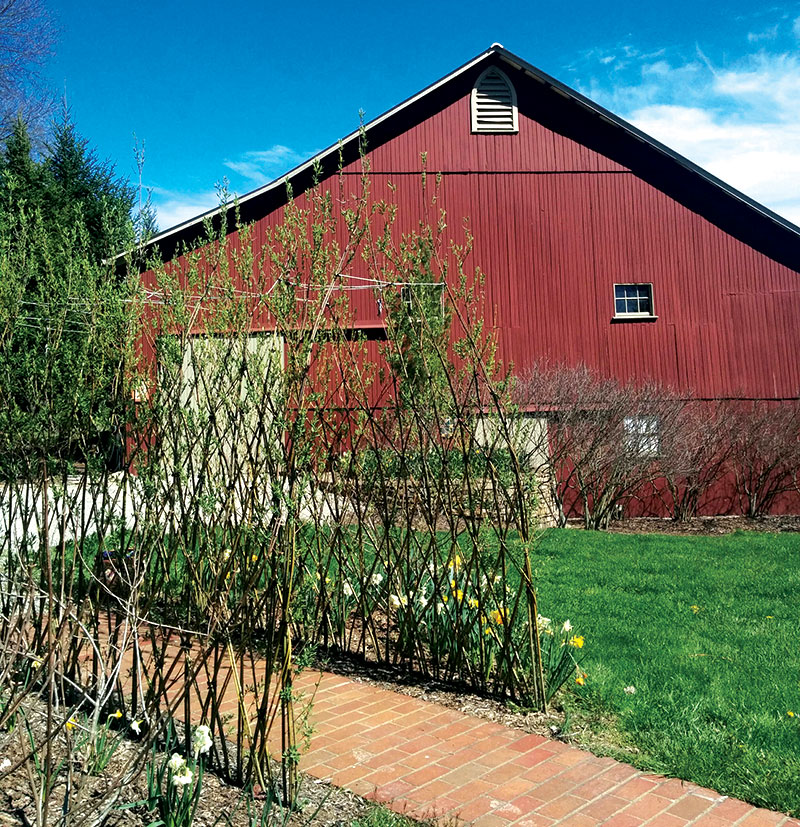
Permaculture is a study of the complex relationships between the many factors that can sustain a productive landscape. Growing according to permaculture principles helps minimize your effort in the garden while maximizing harvests. It promises continuity beyond the typical annual garden as well as benefits to many species and resources.
Permaculture is a term coined by Bill Mollison and David Holmgren in the mid-1970s. It’s a combination of the words “permanent” and “agriculture” (or culture). In Practical Permaculture, authors Jessi Bloom and Dave Boehnlein state that it’s similar to architecture and engineering in that it starts with a design approach.
“Whether we are designing a house, a chicken coop, a garden, a bowling alley or a schoolyard, permaculture is a process that starts with a problem and finds solutions. In permaculture, design decisions are first based on ethics and then incorporate the logic of natural systems. Mimicking nature’s patterns makes our lives more sustainable and less reliant on resources outside of our control.”
They summarize the concept by writing, “permaculture can be defined as meeting human needs through ecological and regenerative design.”
While the idea of gardening in nature’s image can seem appealing, sometimes the recommended ways to do so can be overwhelming. The key is to start where you are and work slowly toward your goal. Here are 10 ways you can begin a permaculture path.
1. Collect & Analyze
Permaculture is practiced in every state and many countries around the world. Seeing permaculture principles in action can truly inspire you, and talking to the practicing gardeners, sometimes called “permies,” can help hone your ideas, avoid pitfalls and access community resources such as free wood chips, tool libraries and local sustainability groups.
Many communities host garden tours that include permaculture gardens. Your local library, plant nursery or newspaper might list tours. Calling the county extension is another way to find a farm open to the public. You can also search for places offering permaculture design courses and visiting hours.
Reading can take you on a virtual permaculture tour. Find beautiful books at your library or browse online. Social media sites, such as Facebook and Meetup, contain local, regional and global permaculture groups filled with encouragement for the beginner.
As you collect, list the resources that speak to you and your needs. Take note of what exists on your property, your gardening goals, and your personal strengths and weaknesses.
2. Design Your Garden

You might plan to create an entire permaculture system from unbroken ground. You might transition an existing garden to permaculture style. Or you also might start a small permaculture bed or project. Regardless, take the experiences and goals defined in the collecting phase and begin defining a plan.
Permaculture designs include consideration for water sources and use; existing land elements, such as elevation and shade; perennial and annual plants, play and gathering spaces; and growth over time. Professional permaculture designers make detailed overlaid paper plans accounting for each of these elements. You can find permaculture design courses, books and videos to guide you in structured planning processes.
Alternatively, create a more casual design in your head or with sketches based on how you know you work and live. A property map from your county auditor or Google Earth is a great place to start a written plan because the physical boundaries and major structures are usually noted. Then you can draw existing plantings and resources in addition to those you intend to add.
There’s no single right way to design a permaculture space, and you can adapt your design to changing experiences, goals or needs.

Herb spirals offer a beautiful garden feature while keeping culinary and medical herbs in one place.
3. Define Water Systems
Water can make or break a garden, and permaculture gardeners see water as a resource to be carefully held and drained in sustainable ways. As you plan your permaculture garden, consider places where water pools and washes away on your property, as well as what areas need water the most.
Where your space holds an excess of water, dig a swale—a very slightly sloped ditch, often lined with gravel—or a pond to contain the water. If you lack water, capture rain from rooftops with cisterns or barrels to use for watering and nonpotable washing.
4. Build & Prep Beds
Permaculture principles call for breaking ground and building new beds using the least destructive methods with minimal effort. For backyard projects, this often includes spot planting and sheet mulching.
Spot planting is when you remove a small section or strip of grass, dig a hole and plant. You might add a slow-release organic fertilizer or compost to the hole. You might also add straw mulch or wood chip mulch around the top to retain moisture and prevent weeds. Spot planting is especially effective for adding bare root trees or increasing the number and variety of perennial flowers in a meadow.
Sheet mulching is a method to turn a larger area into a plantable space. Also called lasagna gardening, sheet mulching is layering materials, such as cardboard, leaves, wood chips and straw, which compost in place to kill grass. Building soil in this way minimizes effort and does not disturb existing soil tilth and microbes. It’s ideal to sheet mulch an area in the fall for planting the following spring.
5. Source Your Perennials
Trying to grow oranges in Oregon is not in line with permaculture principles because the effort required is so great compared with the possible yield. Instead, research what perennial food crops grow well in your planting zone, or, better yet, consider what native plants yield the food, fuel, fiber or medicine you desire.
Sometimes you can plant perennials from wild-crafted seed. More often, though, you find a source of bare-root saplings or transplants. Many county soil and water conservation districts hold sales of native or zone-compatible plants in the spring. Local farmers and garden clubs might have ideas about sourcing less common plants, and many nurseries sell online.
If you have the option, choose a local nursery so that the plants will be most adapted to your soil and weather conditions. You can often join with friends to buy in bulk for lower prices.
6. Start Planting

Lettuce, onions, carrot sand parsley grow in harmony in a permaculture-designed garden.
Eventually, stop planning and gathering resources and put some roots in the ground. If you can afford it, plant more densely than you think you need so you can later select the healthiest plants and remove others for compost or firewood. Dense planting also helps prevent weeds from overgrowing.
Companion plants, such as herbs and alliums (think chives and onions), placed under fruit trees can help prevent disease and digging pests. If your area lacks pollinators, plant flowers that attract them. Many permaculturists seed green manure cover crops to build soil nutrition and tilth while young perennials establish themselves.
Take notes on your permaculture plan as you plant so you remember the variety and planting date. This information can be invaluable if you later have the opportunity to share seeds or cuttings with others.

These hazelnut trees were mulched to control weeds.
7. Intercrop With Annuals
Your permaculture garden will probably look like a field of sticks if you plant young and affordable bare-root fruit and nut trees. For the first few years, fill in the space with annuals. Sunflowers are beautiful, low-maintenance space-fillers, and you can choose varieties for cut flower or edible seed production.
Some people intercrop with squashes or sweet potatoes because the vines are minimally invasive to tree root systems and the spread lessens weed problems. Annual greens, flowers and vegetables can help an establishing permaculture system look full and provide a source of income or food.
Consider covering any remaining bare earth with cover crops or mulch. Turning soil over by tilling or double-digging, a shoveling technique that is a form of hand-tilling, exposes weed seeds buried deep in the earth. Smother the weed seeds and prevent them from taking over by one of two means. One is mulching. Another is to sow a cover crop—try buckwheat for a quick 30-day turnaround in the warmer months, or field pea and oat mix in the cooler months. Cover cropping and mulching also prevent soil erosion and nutrient off-gassing.
8. Maintain
Enjoy your garden! Harvest from the fastest growing, healthiest plants in the first years. Give new perennials plenty of water and weeding if possible so they become well established. Remember: It’s fine to adapt your plan as the seasons and your interests change.
Newly broken ground might reveal challenges in the form of weeds, pests or unexpected plant death. Don’t be upset by this. Rather, consider what you can learn about your land from such challenges.
Perhaps you can identify the weeds as edible and add more wild-harvested foods to your diet. Plants or plant families that don’t thrive where you’ve planted them can reveal water and nutrition patterns that you might correct with swales, cover crops or natural fertilization. Alternately, you might adapt your plan to something better suited to the area.
Wildlife, such as deer, frequently become pests for fruit growers. Some permaculture practitioners plan for a “wildlife share” to account for such crop loss. Others build fencing, while some consider deer the natural pruning crew for whatever fruit trees survive.
9. Add Diversity
Polyculture, the principle of layering many species together, is at the heart of permaculture. As you watch your garden grow, continue to add companion species to what you’ve planted, or allow meadows, windbreaks and forest edges to grow wild. Many permaculture practitioners claim success when they increase the diversity of birds, bees and other wildlife that flock to the wide variety of plantings.
You might add diversity to the structures in your garden too. Consider these:
- A rocket stove, with insulated vertical pipe, is sometimes made into an oven with a packed earth surround. It takes advantage of complete combustion to maximize wood fuel efficiency.
- Hypertufa, a mixture of natural materials such as peat and perlite bound with cement, makes a porous material that is well suited to molding into plant containers, troughs and stands. It ages beautifully, often growing moss and lichen.
- Hugelkultur mounds involve a no-dig method of layering large logs, branches and inverted sod to create a naturally raised bed full of moisture holding capacity and nutrition as the wood breaks down.
- A living fence made from willow (shown below), elderberry or other quick-growing material adds definition to the boundaries of your space, keeps animals or children in or out and attracts bird life.

Each of these structures combines physical advantages with widely available, lower-cost materials to add complexity, beauty and resource to your garden.
10. Share
Contributing to community is a key principle of permaculture and can take many forms. You can share your experience in online and in-person groups or offer to host a garden tour. Donate or sell extra seedlings or produce when you have a good year. Participate in plant swaps or sales to trade your most prolific seeds or plants for new varieties.
In sharing information, experience and plant stock with other permaculture gardeners, abundance and inspiration proliferate.
This story originally appeared in the July/August 2018 issue of Hobby Farms.




